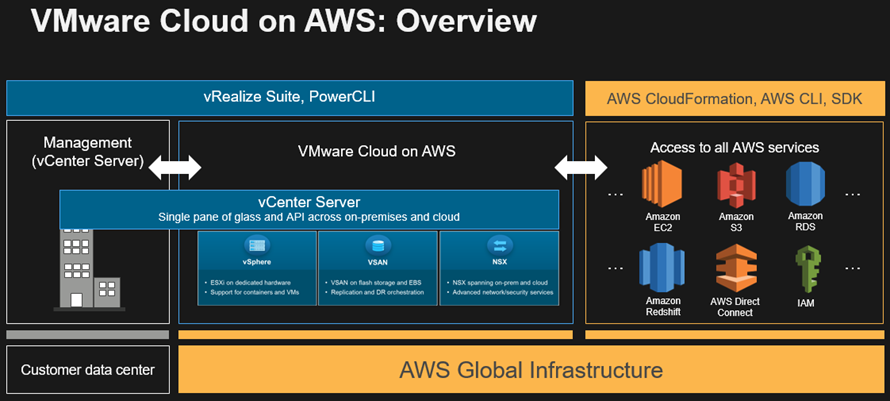AWS News Blog
VMware Cloud on AWS – Now Available
Last year I told you about the work that we are doing with our friends at VMware to build the VMware Cloud on AWS. As I shared at the time, this is a native, fully-managed offering that runs the VMware SDDC stack directly on bare-metal AWS infrastructure that maintains the elasticity and security customers have come to expect. This allows you to benefit from the scalability and resiliency of AWS, along with the networking and system-level hardware features that are fundamental parts of our security-first architecture.
VMware Cloud on AWS allows you take advantage of what you already know and own. Your existing skills, your investment in training, your operational practices, and your investment in software licenses remain relevant and applicable when you move to the public cloud. As part of that move you can forget about building & running data centers, modernizing hardware, and scaling to meet transient or short-term demand. You can also take advantage of a long list of AWS compute, database, analytics, IoT, AI, security, mobile, deployment and application services.
Initial Availability
After incorporating feedback from many customers and partners in our Early Access beta program, today at VMworld, VMware and Amazon announced the initial availability of VMware Cloud on AWS. This service is initially available in the US West (Oregon) region through VMware and members of the VMware Partner Network. It is designed to support popular use cases such as data center extension, application development & testing, and application migration.
This offering is sold, delivered, supported, and billed by VMware. It supports custom-sized VMs, runs any OS that is supported by VMware, and makes use of single-tenant bare-metal AWS infrastructure so that you can bring your Windows Server licenses to the cloud. Each SDDC (Software-Defined Data Center) consists of 4 to 16 instances, each with 36 cores, 512 GB of memory, and 15.2 TB of NVMe storage. Clusters currently run in a single AWS Availability Zone (AZ) with support in the works for clusters that span AZs. You can spin up an entire VMware SDDC in a couple of hours, and scale host capacity up and down in minutes.
The NSX networking platform (powered by the AWS Elastic Networking Adapter running at up to 25 Gbps) supports multicast traffic, separate networks for management and compute, and IPSec VPN tunnels to on-premises firewalls, routers, and so forth.
Here’s an overview to show you how all of the parts fit together:

The VMware and third-party management tools (vCenter Server, PowerCLI, the vRealize Suite, and code that calls the vSphere API) that you use today will work just fine when you build a hybrid VMware environment that combines your existing on-premises resources and those that you launch in AWS. This hybrid environment will use a new VMware Hybrid Linked Mode to create a single, unified view of your on-premises and cloud resources. You can use familiar VMware tools to manage your applications, without having to purchase any new or custom hardware, rewrite applications, or modify your operating model.
Your applications and your code can access the full range of AWS services (the database, analytical, and AI services are a good place to start). Use for these services is billed separately and you’ll need to create an AWS account.
Learn More at VMworld
If you are attending VMworld in Las Vegas, please be sure to check out some of the 90+ AWS sessions:
- AWS 101.
- VMware Cloud on AWS – The Painless Path to Hybrid Cloud.
- VMware Cloud on AWS: Hybrid Cloud Architectural Deep Dive: Networking and Storage Best Practices.
- AWS Native Services Integration with VMware Cloud on AWS: Technical Deep Dive.
- Delivering Hybrid Cloud Architectures for Your Customers with VMware Cloud on AWS.
Also, be sure to stop by booth #300 and say hello to my colleagues from the AWS team.
In the Works
Our teams have come a long way since last year, but things are just getting revved up!
VMware and AWS are continuing to invest to enable support for new capabilities and use cases, such as application migration, data center expansion, and application test and development. Work is under way to add additional AWS regions, support more use cases such as disaster recovery and data center consolidation, add certifications, and enable even deeper integration with AWS services.
— Jeff;